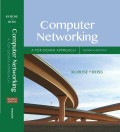
a.
Explanation of Solution
Given that:
There are two nodes named “A” and “B”. The node “A” contains more data to transmit to node “B”. The retransmission probability of node “A” is greater than node “B”.
To find:
- Formula for node “A’s” average throughput.
- Total efficiency
Solution:
Formula for node “A’s” average throughput:
The node “A’s” average throughput is determined by multiplying retransmission probability of A and (1 – retransmission probability of B)...
b.
Explanation of Solution
Given that:
There are two nodes named “A” and “B”. The node “A” contains more data to transmit to node “B”. The retransmission probability of node “A” is greater than node “B”.
Solution:
Throughput of A:
Multiply 2pB inside the brackets =>
Throughput of B:
c.
Explanation of Solution
Given that:
There are “N” number of nodes in which the node “A” has retransmission probability “2p” whereas the other nodes has retransmission probability “p”.
To find: Average throughputs of node “A” and other nodes...
Trending nowThis is a popular solution!

Chapter 6 Solutions
EBK COMPUTER NETWORKING
- P10. Consider two nodes, A and B, that use the slotted ALOHA protocol to con- tend for a channel. Suppose node A has more data to transmit than node B. and node A's retransmission probability pa is greater than node B's retrans- mission probability, PB. PA a. Provide a formula for node A's average throughput. What is the total effi- ciency of the protocol with these two nodes? b. If pA= 2pg, is node A's average throughput twice as large as that of node B? Why or why not? If not, how can you choose PÅ and p to make that happen? c. In general, suppose there are N nodes, among which node A has retrans- mission probability 2p and all other nodes have retransmission probability p. Provide expressions to compute the average throughputs of node A and of any other node.arrow_forwardThis elementary problem begins to explore propagation delay and transmission delay, twocentral concepts in data networking. Consider two hosts, A and B, connected by a single link ofrate R bps. Suppose that the two hosts are separated by m meters, and suppose the propagationspeed along the link is s meters/sec. Host A is to send a packet of size L bits to Host B.a. Express the propagation delay, dprop, in terms of m and s.b. Determine the transmission time of the packet, dtrans, in terms of Land R.c. Ignoring processing and queuing delays, obtain an expression for the endto-end delay.d. Suppose Host A begins to transmit the packet at time t = 0. At time t = dtrans,where is the last bit of the packet?e. Suppose dprop is greater than dtrans. At time t = dtrans, where is the first bit ofthe packet?f. Suppose dprop is less than dtrans. At time t = dtrans, where is the first bit ofthe packet?g. Suppose s = 2.5 · 108, L = 120 bits, and R = 56 kbps. Find the distance mso that dprop equals…arrow_forwardThis elementary problem begins to explore propagation delay andtransmission delay, two central concepts in data networking. Consider two hosts, Aand B, connected by a single link of rate R bps. Suppose that the two hosts areseparated by m meters, and suppose the propagation speed along the link is smeters/sec. Host A is to send a packet of size L bits to Host B. d. Suppose Host A begins to transmit the packet at time t=0 . At time t= ?????? ,where is the last bit of the packet? e. Suppose ????? is greater than ?????? . At time t= ??????, where is the first bit of the packet?f. Suppose ????? is less than ??????. At time t= ?????? , where is the first bit of thepacket?arrow_forward
- A link has a transmission speed of 106 bits/sec. It uses data packets of size 1000 bytes each. Assume that the acknowledgment has negligible transmission delay, and that its propagation delay is the same as the data propagation delay. Also assume that the processing delays at nodes are negligible. The efficiency of the stop-and-wait protocol in this setup is exactly 25%. The value of the one-way propagation delay (in milliseconds) ?arrow_forwardA link has a transmission speed of 106 bits/sec. It uses data packets of size 1000 bytes each. Assume that the acknowledgment has negligible transmission delay, and that its propagation delay is the same as the data propagation delay. Also assume that the processing delays at nodes are negligible. The efficiency of the stop- and-wait protocol in this setup is exactly 25%. The value of the one-way propagation delay (in milliseconds) isarrow_forwardConsider a reliable data transfer protocol that uses only negative acknowledgments. Suppose the sender sends data only infrequently. Would a NAK-only protocol be preferable to a protocol that uses ACKs? Why? Now suppose the sender has a lot of data to send and the endto- end connection experiences few losses. In this second case, would a NAK-only protocol be preferable to a protocol that uses ACKs? Why?arrow_forward
- Consider two systems P and Q connected via a router R with the bandwidth of 2 Gbps. The length of the packet is 1000 bytes. The propagation delay between P and Q is 200 microseconds. The distance between the P and R is 10 km while the distance between R and Q is 5 km. The propagation speed in meter per second if each link is having the same 10³ km/s? propagation speed isarrow_forwardThis elementary problem begins to explore propagation delay and transmission delay, two central concepts in data networking. Consider two hosts, A and B, connected by a single link of rate R bps. Suppose that the two hosts are separated by m meters, and suppose the propagation speed along the link is s meters/sec. Host A is to send a packet of size L bits to Host B. a. Express the propagation delay, dprop, in terms of m and s.b. Determine the transmission time of the packet, dtrans, in terms of L and R.c. Ignoring processing and queuing delays, obtain an expression for the end-to-end delay.d. Suppose Host A begins to transmit the packet at time t = 0. At time t = dtrans, where is the last bit of the packet?e. Suppose dprop is greater than dtrans. At time t = dtrans, where is the first bit of the packet?f. Suppose dprop is less than dtrans. At time t = dtrans, where is the first bit of the packet?g. Suppose s = 2.5 * 108 meters/sec, L = 120 bits, and R = 0.112 Mbps. Find the distance m…arrow_forwardSuppose an application uses rdt 3.0 as its transport layer protocol. As the stop-and-wait protocol has very low channel utilization (shown in the cross country example), the designers of this application let the receiver keep sending back a number (more than two) of alternating ACKO and ACK 1 even if the corresponding data have not arrived at the receiver. Would this application design increase the channel utilization? Why? Are there any potential problems with this approach? Explain.arrow_forward
- Consider a broadcast channel with N nodes and a transmission rate of R bps. Suppose the broadcast channel uses polling (with an additional polling node) for multiple access. Suppose the amount of time from when a node completes transmission until the subsequent node is permitted to transmit (that is, the polling delay) is ?poll. Suppose that within a polling round, a given node is allowed to transmit at most Q bits. What is the maximum throughput of the broadcast channel?arrow_forwardConsider a two-link network in which Host A has a 1 Mbps connection with a 10 ms propagation delay and the router has a 15 Mbps link with a 25 ms propagation delay. Host A sends Host B a 1500-byte packet. What is the packet transmission delay from the router to Host B (in milliseconds)?arrow_forwardConsider two hosts, A and B, connected by a single link of rate R bps. Suppose that the two hosts are separated by m meters, and suppose the propagation speed along the link is s meters/sec. Host A is to send a packet of size L bits to host B. d. Suppose host A begins to transmit the packet at time t= 0, at time t=dtrans, where is the last bit of the packet?e. Suppose dprop is greater than dtrans. At time t =dtrans, where is the first bit of the packet? f. Suppose dprop is less than dtrans. At time t =dtrans, where is the first bit of the packet?g. Suppose s = 2.5 x 108 , L=100 bits, and R=28 Kbps. Find the distance m so that dprop = dtrans.arrow_forward
 Operations Research : Applications and AlgorithmsComputer ScienceISBN:9780534380588Author:Wayne L. WinstonPublisher:Brooks Cole
Operations Research : Applications and AlgorithmsComputer ScienceISBN:9780534380588Author:Wayne L. WinstonPublisher:Brooks Cole Principles of Information Security (MindTap Cours...Computer ScienceISBN:9781337102063Author:Michael E. Whitman, Herbert J. MattordPublisher:Cengage Learning
Principles of Information Security (MindTap Cours...Computer ScienceISBN:9781337102063Author:Michael E. Whitman, Herbert J. MattordPublisher:Cengage Learning Systems ArchitectureComputer ScienceISBN:9781305080195Author:Stephen D. BurdPublisher:Cengage Learning
Systems ArchitectureComputer ScienceISBN:9781305080195Author:Stephen D. BurdPublisher:Cengage Learning A+ Guide to Hardware (Standalone Book) (MindTap C...Computer ScienceISBN:9781305266452Author:Jean AndrewsPublisher:Cengage Learning
A+ Guide to Hardware (Standalone Book) (MindTap C...Computer ScienceISBN:9781305266452Author:Jean AndrewsPublisher:Cengage Learning



